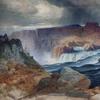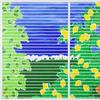“In Giacometti’s Studio – An Intimate Portrait:” Unprecedented Loan from Giacometti Family in Eykyn Maclean’s First Public Exhibition
- October 27, 2010 11:56

(New York, NY) - For its inaugural exhibition, Eykyn Maclean is presenting a unique overview of Alberto Giacometti’s artistic achievement. Dating from 1919 to 1965, the works on view – nearly 100 sculptures, paintings and drawings, as well as photographs and documents – have been selected principally from the collection of Giacometti’s heirs. Supplemented by loans from other prestigious collections, a number of the works on view in this scholarly, not-for-sale exhibition have never been exhibited before.
Both the exhibition and two publications that accompany it focus on the tiny, cluttered studio behind Montparnasse, where Giacometti spent nearly all of the last four decades of his life (1927-66), ceaselessly pursuing his vision of mankind. The studio is presented in this dramatically designed exhibition as both the mirror and the archive of Giacometti’s work, reflecting and recording significant and intimate insights into the artist’s remarkable creativity.
The exhibition has been curated by art historian Michael Peppiatt, whose lifelong fascination with Giacometti’s studio began when he went to live in Paris in 1966 and became close to the artist’s family and inner circle of friends. Peppiatt’s new book, “In Giacometti’s Studio,” will be published by Yale University Press to coincide with the opening of the show at Eykyn Maclean.
“It is a great privilege to be able to exhibit such an important group of sculpture, drawings and archival material direct from Giacometti’s family”, commented Christopher Eykyn, partner in Eykyn Maclean, “and we are also thrilled to include a number of important loans from other wonderful collections. Importantly, Michael Peppiatt’s involvement with the show as curator and author has provided several new insights into the artist’s work.”
An illustrated exhibition catalogue will also be available at the gallery. The catalogue includes a recent interview conducted for inclusion in the publication between Dr. Peppiatt and the 83-year old poet and Giacometti expert, Jacques Dupin, describing Dupin’s close friendship with the artist and his regular visits to the studio, notably while Giacometti was painting his portrait. The painting is included in the exhibition.
With the exception of four years during World War II, Giacometti worked from 1927 until 1966 in a ramshackle and dilapidated 12-by-15 foot studio on rue Hippolyte Maindron in the Montparnasse section of Paris. As Peppiatt recounts in his new book, Giacometti said of his studio, “I planned on moving as soon as I could because it was too small – just a hole. But the longer I stayed, the bigger it grew.”
Although modest if not outright spartan (it contained no indoor plumbing or electricity until the 1950s) and strewn with plaster, sculpting tools, canvases, and paint brushes, the studio was an artistic and intellectual center during an era when Paris was a cultural capital of Europe. Among the people who visited the studio were André Breton, Pablo Picasso, Jean-Paul Sartre, Jean Genet, Antonin Artaud, Marlene Dietrich, and Samuel Beckett, for whom Giacometti created the set design of the Théâtre de l’Odéon’s 1961 production of Beckett’s “Waiting for Godot.”
Giacometti arrived in Paris in 1917 and by the late-‘20s, at the urging of Breton, had become part of the Surrealist circle. Although he broke with the group in the mid-1930s over his interest in the human figure, the influence of the Surrealist movement continued in his work into the 1940s, as evident in Le nez (1947), a human head with a fantastically extended swordfish-like nose and gaping mouth, suspended from a cage-like structure.
From the 1940s onward, Giacometti focused not only on depicting the human figure but also crucially on its relationship to the space around it. “If I look at a woman on the opposite pavement and I see her as very small, I marvel at that little figure walking in space, and then, seeing her still smaller, my field of vision becomes much larger,” he wrote. “I see a vast space above and around, which is almost limitless.”
In addition, portraying the human head was an interest of Giacometti’s that Breton scorned. “I’ll never manage to put into a portrait all the power a head contains,” he wrote. “Just the fact of living requires so much will-power and energy.”
“In Giacometti’s Studio” contains examples of each. Among them is the monumental 1954 bronze, Grande tête/Tête mince. At over two feet tall, it is the largest of Giacometti’s busts executed in the 1950s and continues a series he started in 1951. Where his thin, almost weightless attenuated sculptures contemplated the figure in space, through his busts Giacometti sought to create weight and density: the shoulders and head in profile are heavy and substantial, while the frontal view has the face almost reduced to a knife’s edge.
Among the standing figures in the exhibition are Femme de Venise V, which was part of the series Giacometti created to be exhibited in the French pavilion of the 1956 Venice Biennale, and Trois hommes qui marchent II – three men atop an elevated pedestal, walking across each other’s path and yet unaware of their mutual existence. As withGiacometti’s other renderings of the subject, the static figure’s head is small and recessive, suggesting an object and presence that is universal rather than individuated.
Throughout his life, Giacometti drew copies of works he admired that were illustrated in art books, Peppiatt notes in his book. Giacometti’s ballpoint pen sketch, Portrait de van Gogh (Le Post-Impressionisme, John Rewald, 1961) loosely copied van Gogh’s self portrait of 1889-1990, increasing the angularity of van Gogh’s bone structure and narrowing the head. Shown opposite a photographic reproduction of the painting, the drawing suggests the lens through which Giacometti viewed his sitters.
Eykyn Maclean is a private gallery based in New York and London that specializes in museum quality Impressionist and 20th century European and American Art. Christopher Eykyn and Nicholas Maclean established the gallery in 2006 after a combined 29 years at Christie's, where they were co-heads of the Impressionist and Modern Art department.

















_(17100x100_c.jpg)



